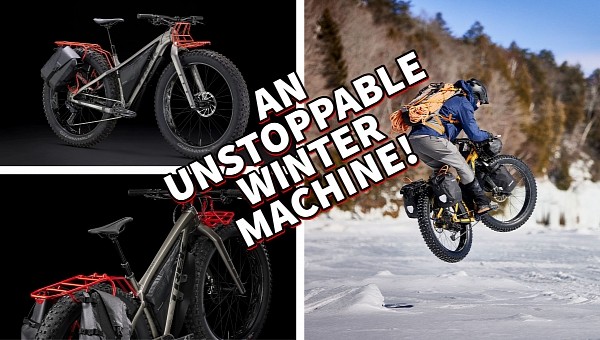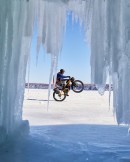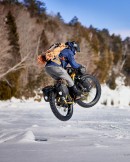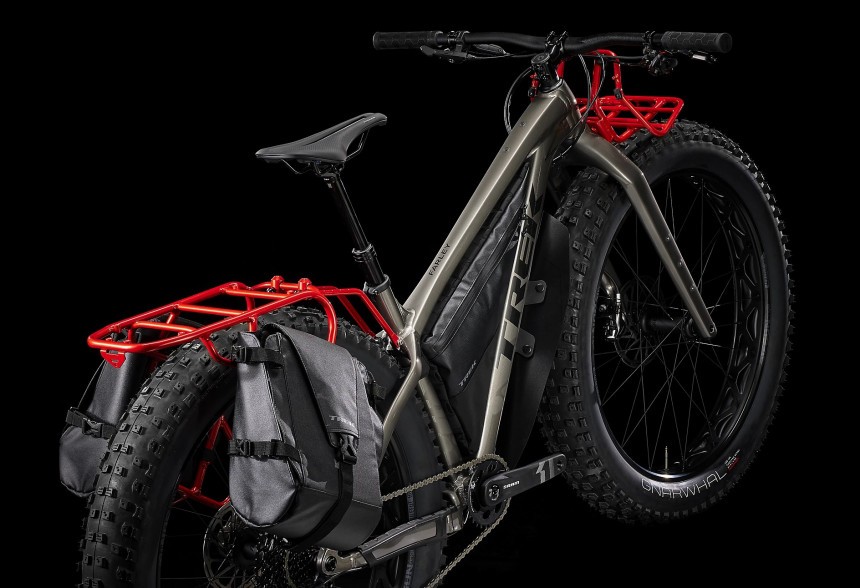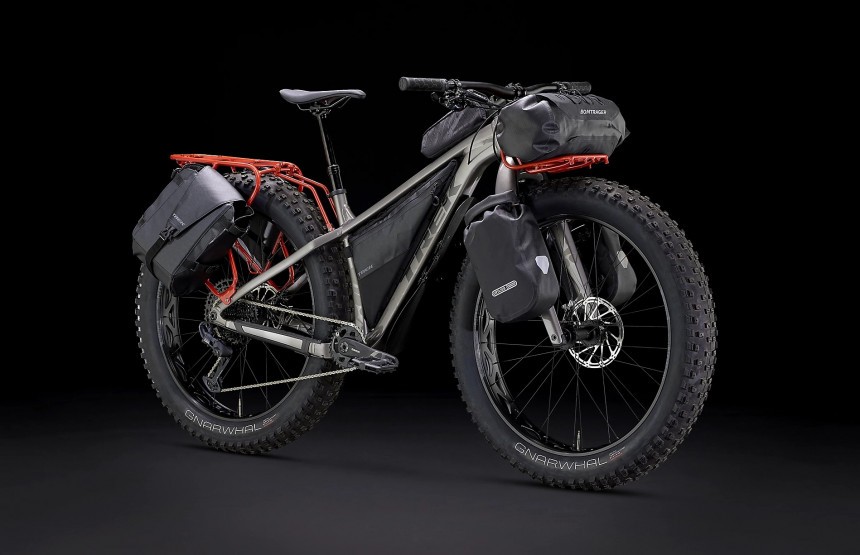Let's face it, whenever we see a fat tire bike, our first instinct is to run. However, here are world-renowned Trek Bicycles with their Farley lineup, ready to take your cash. Oh, and they are catching on because here's the special Winter Edition model.
At $4,000 (€3,700 at current exchange rates), you can bet your bottom dollar that the Farley 9 Winter Edition (WE) is a bit different than any other fat tire bike you may have encountered recently. Just as its name would suggest, this two-wheeler is designed for one thing and one thing only, full-on snow and winter wonderland domination. Grab a helmet, and let's take a ride on this monster of a beast.
Now, a few things set the Farley lineup apart from other bicycles under the Trek umbrella, but the main idea is that these babies are meant for off-road exploration. Just like all the other Farley bikes to appear over the years, the WE are built in a similar fashion, with fat tires. But, to make it a bit more special, the manufacturer is using "extra-wide" tires with a 4.5 in cross-section.
What are the benefits and downsides of fat tires? One reason these massive balloons are now a part of the cycling industry has a whole lot to do with comfort and capability. You may have noticed that most bikes with such tires typically include no suspension. That's because there's 4.5 in of space between your rim and the ground. Any hits you take are absorbed by that space, so rides are typically plusher.
To achieve this, fat tires are typically more elastic than your average MTB tire, and this is where we encounter some downsides. Because it's softer, it typically means that it's easier to pop. Some manufacturers do apply an array of materials and weave patterns in creating these babies, so the chances of you getting stranded in the middle of nowhere are smaller.
But the softness also does something for your ride that other classic tires can't. A softer pressure allows the tire to relax more, creating a larger contact patch. This is typically a no-no in the cycling world, but it's the main reason you can see a fat bike hauling its butt through sand and snow. These terrains also lower the chances of you popping your balloons, so ride away. As for an urban setting, those knobs are going to be loud and inefficient. However, with some electric power, you'll find that the ride is rather nice. Did I mention that the front fork is built out of carbon fiber? That, too, should help reduce some of the vibrations you encounter during your rides.
Diving deeper into the WE's abilities, I particularly enjoyed seeing Trek climbing aboard the whole bikepacking craze that's taking the world by storm. Not only does the frame include mounts all over the main triangle, but the fork and seat stay can take cargo racks too. Best of all, Trek includes those racks and cargo bags as standard in the $4K. This means you can run through a component and safety check, and off you go.
As for the drivetrain on this bugger, Trek has called upon the powers of SRAM to transfer your energy into the rear wheel. At the front, an itsy bitsy X1 1000 Eagle ring with 30T runs an NX Eagle chain over a PG-1230 cassette with 11-50T. In short, a rather solid MTB setup with more than enough range to tackle slopes and fly downhill. Adding more to the MTB capabilities, a dropper post is standard in all WE two-wheeler trinkets, and CenterLine brakes with 160 mm (6.3 in) rotors are also in place. The manufacturer's website also showcases 180 mm (7.1 in) rotors.
Once everything is thrown onto the aluminum frame used to define the Farley, all we're looking at is a two-wheeler with a weight of 18.3 kg (40.3 lbs) for a medium size. Then there's the weight limit, including bike, rider, and cargo, of 136 kg (300 lb). It should be enough for the average Joe to bring along quite the pounds of gear.
What does all this mean for folks like you and me? Let's find out. Imagine it's the middle of winter. In some places in the world, snow is still falling. If you get lucky and the sun shines on one of your days, throw on a jacket, biking shoes, and some food and water, and ride on. Sure, riding a bicycle when everyone else is flying around on snowmobiles may be an odd sight. But it goes to show just how passionate you are about these two-wheelers.
Actually, bikes like these are nothing more than a tool. A tool to help you feed your need to explore no matter the season, landscape, or weather. For that, a fat tire bike like the Farley is worth considering. Heck, come summer, I'm sure you can take this puppy down to the beach and explore a different setting. This time, you'll be carrying a giant umbrella, some towels, a beach ball, and food. Hmm, Winter Edition? Sounds more like the Year-Round Edition to me.
Now, a few things set the Farley lineup apart from other bicycles under the Trek umbrella, but the main idea is that these babies are meant for off-road exploration. Just like all the other Farley bikes to appear over the years, the WE are built in a similar fashion, with fat tires. But, to make it a bit more special, the manufacturer is using "extra-wide" tires with a 4.5 in cross-section.
What are the benefits and downsides of fat tires? One reason these massive balloons are now a part of the cycling industry has a whole lot to do with comfort and capability. You may have noticed that most bikes with such tires typically include no suspension. That's because there's 4.5 in of space between your rim and the ground. Any hits you take are absorbed by that space, so rides are typically plusher.
To achieve this, fat tires are typically more elastic than your average MTB tire, and this is where we encounter some downsides. Because it's softer, it typically means that it's easier to pop. Some manufacturers do apply an array of materials and weave patterns in creating these babies, so the chances of you getting stranded in the middle of nowhere are smaller.
Diving deeper into the WE's abilities, I particularly enjoyed seeing Trek climbing aboard the whole bikepacking craze that's taking the world by storm. Not only does the frame include mounts all over the main triangle, but the fork and seat stay can take cargo racks too. Best of all, Trek includes those racks and cargo bags as standard in the $4K. This means you can run through a component and safety check, and off you go.
As for the drivetrain on this bugger, Trek has called upon the powers of SRAM to transfer your energy into the rear wheel. At the front, an itsy bitsy X1 1000 Eagle ring with 30T runs an NX Eagle chain over a PG-1230 cassette with 11-50T. In short, a rather solid MTB setup with more than enough range to tackle slopes and fly downhill. Adding more to the MTB capabilities, a dropper post is standard in all WE two-wheeler trinkets, and CenterLine brakes with 160 mm (6.3 in) rotors are also in place. The manufacturer's website also showcases 180 mm (7.1 in) rotors.
What does all this mean for folks like you and me? Let's find out. Imagine it's the middle of winter. In some places in the world, snow is still falling. If you get lucky and the sun shines on one of your days, throw on a jacket, biking shoes, and some food and water, and ride on. Sure, riding a bicycle when everyone else is flying around on snowmobiles may be an odd sight. But it goes to show just how passionate you are about these two-wheelers.
Actually, bikes like these are nothing more than a tool. A tool to help you feed your need to explore no matter the season, landscape, or weather. For that, a fat tire bike like the Farley is worth considering. Heck, come summer, I'm sure you can take this puppy down to the beach and explore a different setting. This time, you'll be carrying a giant umbrella, some towels, a beach ball, and food. Hmm, Winter Edition? Sounds more like the Year-Round Edition to me.
